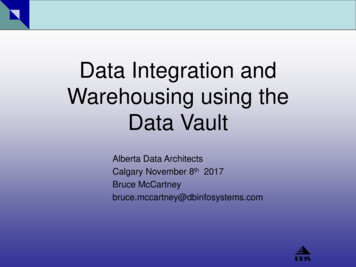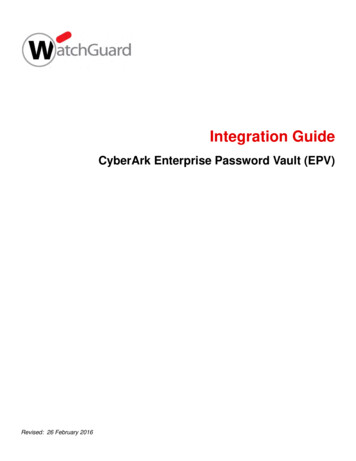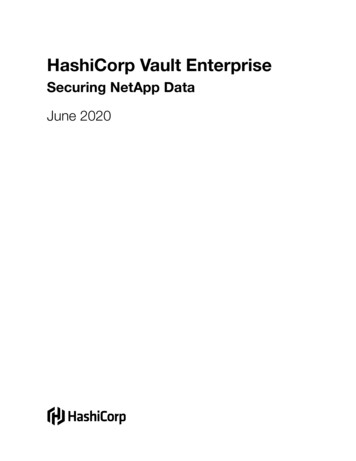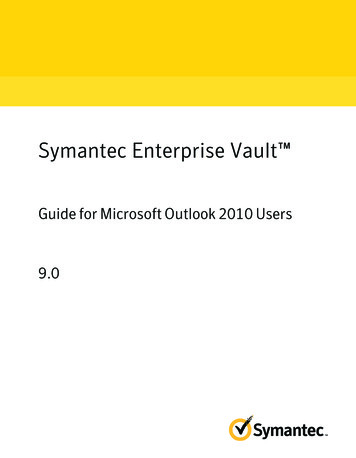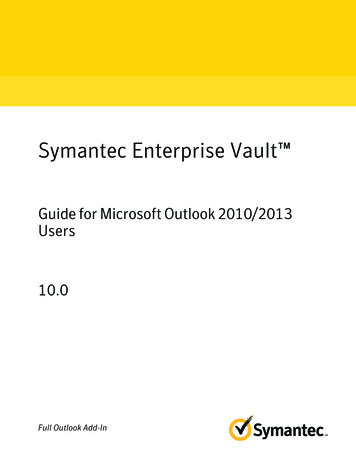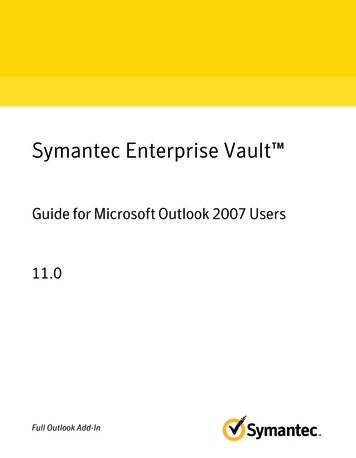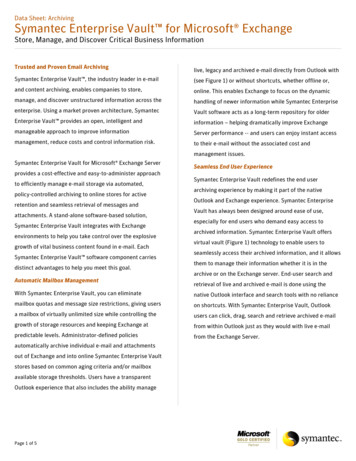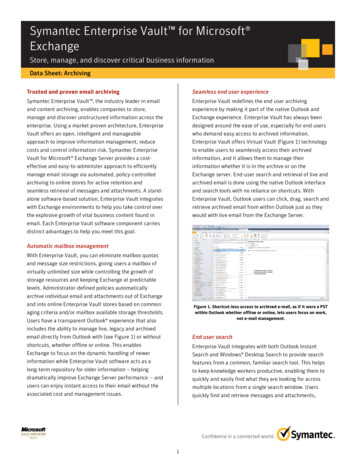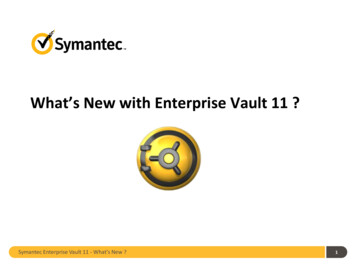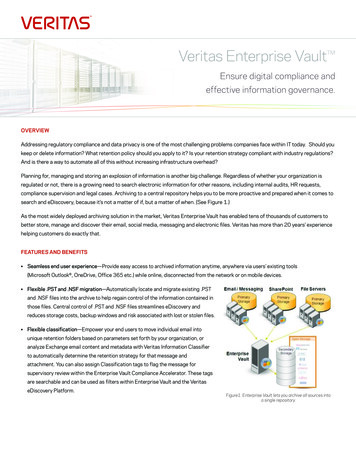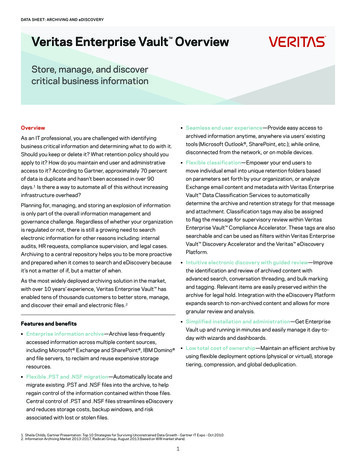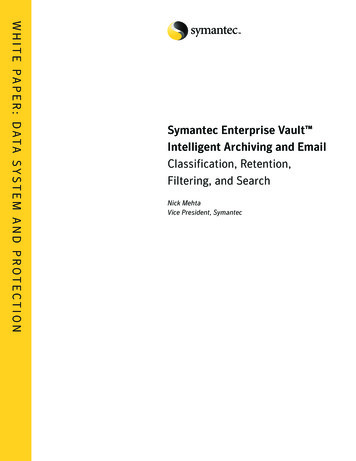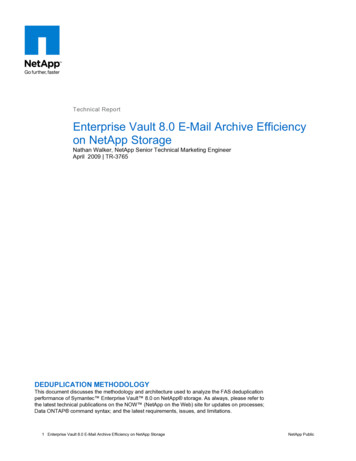
Transcription
Technical ReportEnterprise Vault 8.0 E-Mail Archive Efficiencyon NetApp StorageNathan Walker, NetApp Senior Technical Marketing EngineerApril 2009 TR-3765DEDUPLICATION METHODOLOGYThis document discusses the methodology and architecture used to analyze the FAS deduplicationperformance of Symantec Enterprise Vault 8.0 on NetApp storage. As always, please refer tothe latest technical publications on the NOW (NetApp on the Web) site for updates on processes;Data ONTAP command syntax; and the latest requirements, issues, and limitations.1 Enterprise Vault 8.0 E-Mail Archive Efficiency on NetApp StorageNetApp Public
TABLE OF CONTENTS1EXECUTIVE SUMMARY . 32INTRODUCTION. 33AUDIENCE . 34SCOPE . 35TECHNOLOGY INTRODUCTION . 36TESTING OBJECTIVES. 47TESTING ENVIRONMENT METHODOLOGY . 48LAB ENVIRONMENT DETAILS. 109RESULTS AND ANALYSIS . 1110CONCLUSION . 1411REFERENCES. 152 Enterprise Vault 8.0 E-Mail Archive Efficiency on NetApp StorageNetApp Public
1EXECUTIVE SUMMARYSymantec Enterprise Vault 8.0 is today’s leading e-mail and content archiving solution. Enterprise Vaultreduces the amount of storage required for e-mail and file systems by managing content using automated,policy-controlled archiving to online stores for active retention and seamless retrieval of information.Companies using Enterprise Vault on NetApp storage can expect to reduce their e-mail storage requirementsby 50% or more, while enabling satisfaction of regulatory and legal requirements. Now you can streamline youroperations and minimize your risk with solutions from NetApp.2INTRODUCTIONIT organizations are finding ways to intelligently manage exploding e-mail repositories. These groups aretransparently moving less frequently accessed e-mail to lower-cost storage using proven technologies. As mailis moved from a flat storage model to a sophisticated archive solution, more data can be managed at a lowercost per megabyte. While reducing IT operations costs, these efforts also establish a foundation to satisfycompliance, records retention, and legal hold requirements. When combined with SnapLock , archive datapermanence is assured on WORM volumes. Innovative storage and data management technology solutionsfrom NetApp and Symantec provide an optimized stack to archive corporate data. Duplicate mails and mailattachments can be stored as a single instance within Enterprise Vault. Duplicate blocks of data can beremoved to provide a massively dense and highly efficient archive storage tier for the e-mail archive. You canachieve the most efficient e-mail archiving platform using proven and reliable solutions built upon Symantecand NetApp storage solutions.3AUDIENCEThis paper is intended to serve as a strategic planning guide for organizations with data archiving and retentionrequirements. Readers of this document should have a basic understanding of Symantec Enterprise Vault,Microsoft Exchange, Microsoft SQL Server , and NetApp storage systems. This paper is not intended as areplacement for vendor documentation or proper product training. Consult with those vendors for productfeature and operating details.4SCOPEThe primary intention of this paper is to analyze the storage efficiency capabilities of NetApp deduplication forFAS when used with an Enterprise Vault 8.0 optimized single-instance storage model, or OSIS, to storearchived mail content. A comparison will be made between this archiving paradigm and the more familiarparadigms of personal storage table (PSTs) and Microsoft Exchange. While in the Enterprise Vault 8.0 archive,only the native Symantec compression was used; no attempt was made to evaluate third-party compressionalternatives, although the modular architecture of Enterprise Vault 8.0 does permit such decisions. Contentarchives on WORM storage are discussed in this paper, but were not tested for dedupe performance as thealgorithms are the same for WORM and non-WORM storage.5TECHNOLOGY INTRODUCTIONEnterprise Vault 8.0 is the latest version of the Symantec industry-leading e-mail and content archivingplatform. This release was designed with a new set of capabilities and features to provide optimized storage,management, and discovery of corporate data. Among its updated features is OSIS, which is designed to keepsingle copies of individual e-mails or files regardless of the number of times they occur or from what contentsource they originate. In addition, the storage interface for Enterprise Vault has been rewritten to make surethat new data blocks are written to align with block boundaries of the storage subsystem. This key improvementfacilitates deduplication of data at the storage volume tier. When data writes start at the beginning of the block,there is a higher probability of duplicate blocks for archived content. This means data archives written after theEnterprise Vault 8.0 upgrade will have a greater contribution to data deduplication than those written before.3 Enterprise Vault 8.0 E-Mail Archive Efficiency on NetApp StorageNetApp Public
NetApp deduplication is a fundamental component of Data ONTAP. NetApp has the first deduplicationcapability that can be used broadly across many applications, including primary data, backup data, and archivaldata. NetApp is the only vendor with a dedupe WORM-compliant storage system. Data ONTAP 7.3.1 andabove feature the ability to dedupe a SnapLock FlexVol volume in either compliance or enterprise mode.NetApp offers the only suitable platform for strict adherence to SEC 17a-4, NASD 3110, DOD 5015, SarbanesOxley, and HIPAA requirements.6TESTING OBJECTIVESThe objective of this paper was to analyze the storage efficiency of Enterprise Vault 8.0 on NetApp storage.The paper discusses the findings and results of a production archive migration from Enterprise Vault 2007 toEnterprise Vault 8.0, with storage deduplication turned on. Additionally, comparisons will be made to the samemail in the Microsoft PST format as well as an Exchange 2003 message store.7TESTING ENVIRONMENT METHODOLOGYA production e-mail archive was used to evaluate the storage efficiencies of the combined Symantec andNetApp storage efficiency solution. Due to time and resource constraints, the entire 1.3TB of the sourceEnterprise Vault 2007 archive was not processed. The Enterprise Vault 2007 vault store, index, and SQLServer database were copied to a lab environment using Volume SnapMirror . The disaster recoveryprocedures in the Enterprise Vault administrator’s guide included with the application binaries were used tobring up the archive in a lab environment with all guest OSes configured identically on three IBM xSeriesservers functioning as VMware ESX hosts. Figure 1 shows a representation of the environment.4 Enterprise Vault 8.0 E-Mail Archive Efficiency on NetApp StorageNetApp Public
Figure 1) Enterprise Vault 8.0 lab logical architecture.Once the copy of the production archive was recovered and brought online, a FlexVol volume was created tostore the PST files extracted from the recovered archive. The export archive wizard was then used to extractmail from all archives within a 62-day window. This produced 100GB of PSTs from 859 mail archives. Not allarchives in the source vault store had archived content during that period. Next, two organization units (OUs)were created in Active Directory for both application scenarios. Finally, Microsoft’s csvde utility was used toquickly populate each of the OUs with 859 Active Directory mailbox-enabled users. The usernames wereconcatenated with “.2007” or ”.8” to clearly distinguish each account. Because a disaster recovery scenario ofan Enterprise Vault vault store does not require recovery of Active Directory, no attempt was made to recreatethe original AD topology or user accounts. Only the relevant user accounts were created in the labenvironment.5 Enterprise Vault 8.0 E-Mail Archive Efficiency on NetApp StorageNetApp Public
A screenshot of the Active Directory Users and Computers console is shown below, with the names of theusers blocked out for privacy OUs.6 Enterprise Vault 8.0 E-Mail Archive Efficiency on NetApp StorageNetApp Public
To house the vault store partitions for proper analysis, two FlexVol volumes were created on the NetAppaggregate, named ev2007 arch and ev8 arch, accordingly using the command line interface.Figure3)FlexVolcopycreation.A Windows batch script was written to use xcacls to assign the correct NTFS permissions for each PST to itscorresponding mailbox archive. The archiving policy was modified to accept all of the default Outlook objectclasses. Two provisioning groups were created, corresponding to each of the OUs. Then the import processwas able to begin.The Enterprise Vault import wizard was used to bring each user’s 62-day window of mail from PSTs using thePST import wizard into the Enterprise Vault 2007 vault store, with the new partition on the dedicatedev2007 arch FlexVol volume. To expedite the process, shortcuts were not created for the archived content.Because the Exchange, Enterprise Vault, and Active Director and SQL Server servers were all guest OSs inESX hosts, the import performance was considerably lower than with physical servers. Symantec fully supportsESX as a virtualization environment, but warns customers of the degradation. Refer to the Enterprise Vault 8.0performance guide for a more detailed virtualization discussion.(1)7 Enterprise Vault 8.0 E-Mail Archive Efficiency on NetApp StorageNetApp Public
After verifying the state of the Enterprise Vault 2007 imports, the environment was upgraded to Enterprise Vault8.0. A new vault store group was created for this scenario with its partition placed on the dedicated ev8 archFlexVol volume. The storage type was set to “NetApp Device” to make sure of proper block alignment to theWAFL file system, as shown in Figure 4.Figure4)NewpartitioncreationonNetAppstorage.8 Enterprise Vault 8.0 E-Mail Archive Efficiency on NetApp StorageNetApp Public
The sharing was set to be at the vault store level, as shown in Figure 5. The other partition was closed, andimports began with copies of the same PSTs used for the previous import. After the imports had finished, athorough review of the message count per archive and event logs was completed to make sure there wereduplicate objects in both vault stores.Figure5)Vaultstoregroupproperties.The PST processing rate for the above export and import workflows averaged about 0.8GB per hour. Becausesome users had manually sent items to the archive of a nonstandard class, these were not recognized by thearchiving policy and were therefore omitted in both the Enterprise Vault 2007 and the Enterprise Vault 8 importprocesses.9 Enterprise Vault 8.0 E-Mail Archive Efficiency on NetApp StorageNetApp Public
Finally FAS deduplication was turned on for the FlexVol volumes holding the Enterprise Vault 2007 partitionand the Enterprise Vault 8 partitions. Review TR-3505 for deployment and implementation details for FAS andV-Series deduplication.(2)Figure6)EnablingFASdedupe.As a final comparison, all content from the Enterprise Vault 8 vault store archives was exported back to thecorresponding mailboxes. Because shortcuts were not created in the mailboxes, the archives and themailboxes had identical content. This was completed to serve as an Exchange baseline of identical content. All859 mailboxes were in the same vault store, with the EDB file located on a dedicated FlexVol volume. Theauthor of this document recognizes that Exchange 2003 uses single instancing within the same message storewhen mail is delivered by normal mechanisms. Pushing content from the archive into the Exchange mailboxesdid not single-instance the mail or attachments. However, messaging architects recognize Exchange 2003 and2007 single-instance storage as a performance feature, not as a storage optimization consideration.(3)(4)Therefore, Exchange single instancing is often completely overshadowed by database white space and otherfundamental Exchange characteristics.8LAB ENVIRONMENT DETAILSThis section lists the relevant technical details of the lab environment. As noted earlier, a single NetAppFAS3050 held the VMFS volumes, the iSCSI LUNs for the Exchange and SQL Server databases, and the CIFSshares for the Enterprise Vault archives. This particular arrangement would not be recommended for aproduction environment. Enterprise Vault requires either local disks or virtual local disks for the SQL Serverdatabases and logs, Enterprise Vault, and Microsoft Exchange Server. Either SAN or IP-based SAN satisfiesthese requirements. This does not preclude having all these volumes on a single storage system. NetApp’smultiprotocol block-based and file-based storage means iSCSI, FCP, NFS, and CIFS protocols can be used foraccess to SATA and FC disks, again on a single storage controller, if desired.10 Enterprise Vault 8.0 E-Mail Archive Efficiency on NetApp StorageNetApp Public
tApp storage systemData ONTAP versionDisk protectionDetailsFAS3050 (not clustered)7.3.1RAID-DP tModelProcessorsHyperthreadingNIC quantity/speedInternal diskESX versionRAMDetailsIBM eserver xSeries 3361 Xeon CPU, 3.0 GhzActive4 /1Gb (two active connections)3 x 36GBESX 3i, 3.5.0, ComponentMemoryCPU quantityNIC quantity/speedDetails4GB2 vCPU2 x nterprise Vault (before upgrade)Enterprise Vault (after upgrade)Enterprise Vault 8.0 hotfixE-mailDatabaseOperating system (all)Microsoft iSCSI software initiatorNetApp iSCSI Windows host utilitiesNetApp SnapDrive 9Details7.5.4.25348.0.0.1405Enterprise Vault 8.0 Hotfix Etrack 1499601 319373Microsoft Exchange 2003, 6.5.6944.0Microsoft SQL Server 2005, 9.00.1399.06, Standard EditionMicrosoft Windows 2003, SP2, Standard Edition2.074.1.2732.13355.0.1RESULTS AND ANALYSISThere are a number of ways to generate synthetic content for Exchange and subsequently send it to anarchive. While these methods may provide critical details on processing rates, IOPs, general throughput, andhardware sizing, they are not as effective in guiding storage architects toward effective storage efficiency usingsingle instancing and deduplication. Synthetic content will not single instance, compress, or deduplicate in thesame way that real-world data would. So while the cross-section of production Exchange mail analyzed isunique to this environment, it serves as a real-world case study into the tangible benefits of using EnterpriseVault 8.0 on NetApp storage platforms.Factors such as attachment types, application versions used to create attachments, sharing boundaries,attachment reuse, numbers of recipients, and the underlying storage system will all introduce tremendousvariability in the final Enterprise Vault storage efficiency levels.In particular, Microsoft Office introduces a number of elements that make it challenging to calculate storagesavings. When Office 2003 documents are received as attachments, the fingerprint of the document changes.Outlook modifies the document summary information when the document is inserted into a mailbox. So it is a11 Enterprise Vault 8.0 E-Mail Archive Efficiency on NetApp StorageNetApp Public
completely different fingerprint if originated from the file system. A scenario when production environmentswould be affected would be if file system archiving and mail archiving were to use the same vault store, nowpossible with Enterprise Vault 8.0. Office 2003 also modifies the metadata of documents when they are printed;the “printed date” is stored internally. So differences make it impossible to store what appear to be identicaldocuments, as the fingerprints are different. This Outlook issue has been corrected with Office 2007.Fortunately, there is a higher compression capability with Office 2007 documents. Symantec has noticed a mixof attachments that consist mainly of Office 2003 documents compresses to 60% of its original size. A mix ofattachments that consists mainly of Office 2007 documents compresses to 90% of its original size. This wassampled using Enterprise Vault 8.0 for mailbox archiving, with its own compression. When there is morecompression at a higher level (for example, application) the block deduplication strategies need to be moresophisticated.The number of recipients who are copied on the messages also plays an important role in the storagereduction. A custom SQL Server script was used to calculate the SIS ratio, or the number of references to SISparts divided by the total number of SIS parts. For the imported mail content the ratio was 2.16. A highernumber means there is more shared content, and OSIS will play a more significant role in reducing EnterpriseVault 8.0 content, compared to earlier application versions.Another custom SQL Server script was used to generate the following table, demonstrating the number ofshared parts and the percentage by which they were compressed. NULL type extensions are messages ormessages with small attachments that are stored as sharable parts.Additional details on both of these SQL Server scripts are available through your NetApp sales representative.Table5)Top15SISobjecttypes.File zip*.gz*.ppt*.jpg*.pdf*.xls*.docNULLTotal StoredSIS 0%18.21%76.87%51.82%70.05%12 Enterprise Vault 8.0 E-Mail Archive Efficiency on NetApp StorageNetApp Public
Across all attachments, the average file was compressed by Enterprise Vault to 46% of its original size.Historically, all content in Enterprise Vault was compressed without any administrator visibility or control. Newto Enterprise Vault 8 is the ability to configure compression through the checkboxes on the volume tab of thepartition properties. The first box controls a little more than is indicated by the online documentation.Discussions with Symantec engineers have clarified the actions resulting from selecting the first checkbox:compressed DVS files and uncompressed DVSSP files are created. Enterprise Vault still performs its ownsingle-instance storage, but because the DVSSP files are not compressed, other applications can dedupe withthese files. If the second checkbox is selected, no files are compressed at all.Figure7)Volumetabofpartitionproperties.Early tests with the beta version of Enterprise Vault 8.0 indicated maximal storage efficiency was achievedwhen both checkboxes were left unselected. Even with Enterprise Vault making every attempt to removeredundancy and compress content, there are still opportunities for the underlying storage system to makesignificant reductions in the storage footprint by performing block deduplication.13 Enterprise Vault 8.0 E-Mail Archive Efficiency on NetApp StorageNetApp Public
Table 6 summarizes t
from NetApp and Symantec provide an optimized stack to archive corporate data. Duplicate mails and mail attachments can be stored as a single instance within Enterprise Vault. Duplicate blocks of data can be removed to provide a massively dense and highly efficient archive
